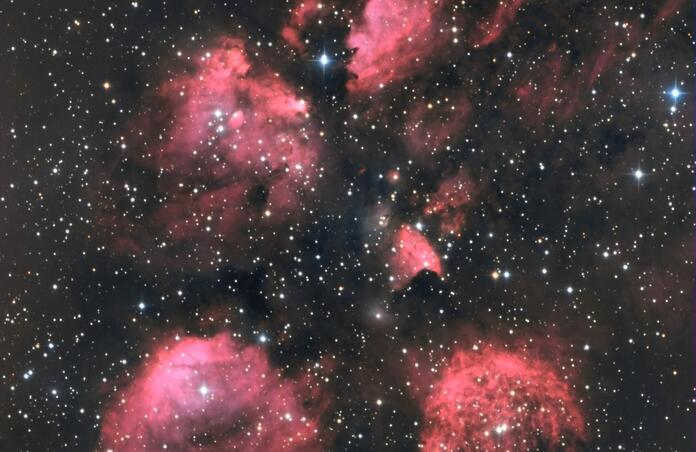Masking in Lightroom

Masking is a mystery to some people when processing their astrophotos. It doesn’t have to be. I must admit, I am not a big fan of the masking tools in PixInsight. I have found that using Lightroom is a more visual experience. It still requires skill and forethought, but it seems a bit more intuitive to me.
Why mask in the first place? What is masking?
Masking is a way to limit the application of adjustments to a specific area. The name comes from the old photography and print-making days when using large negatives, the printer would apply a litho mask. That red material, “ruby lith,” would block the actinic light from reaching the light-sensitive emulsion during printing. This essentially masked the light.
The name stuck as the operation was taken over by software.
Opening Lightroom in Develop mode, we can find the icon for Masking–kind of a circle with a dotted line. A shortcut key of “shift-W” will get you to the same place.
Once clicked, a context dialog opens to Add New Mask.
The options are Select Subject, Select Sky, Brush, Linear Gradient, Radial Gradient, Color Range, Luminance range, and Depth Range.
They all do the same thing–create and apply a mask. The only difference is the geometry or shape of the mask.
To use the mask, for example–the brush mask, just paint the area you wish to affect (which is the opposite of what Masking usually does).
Then, using the slider, you can make any adjustments you wish–exposure, highlights, shadows, and contrast and immediately see the effects in the image.
There is a little (+) sign to add additional masks and affect each one separately. Masks can be altered in size or affect after the fact by selecting the mask from in the dialog.
In addition to the brush, the shapes that can be selected and sized are:
- Linear gradient: drag it from an edge and affect a more extensive, rectangular portion.
- Radial gradient: drag it from the center to affect a circular portion.
- Color range: an interesting mask that can affect an area based on its color–how about bringing out just the reddish HA?
- Luminosity range: another interesting adjustment featuring the ability to affect an area based upon its relative brightness–Central cores, anybody?
The last one isn’t used for most cameras. It is a feature of phone cameras that provide a depth map and can effectively alter the image based upon where in the photo the focus lies.
In addition to these masking choices, you will see “Select Subject” and “Select Sky.” I haven’t found these useful for astrophotography, but they can be used to a significant advantage in terrestrial subjects. They do what they say.
In all cases, the edges of the effect can be feathered to produce a harder or softer separation from the unaffected area.
This may not cover what as well as a tutorial would cover the subject. This article is the result of a request from one of the members of the community. If you have a topic you would like one of the experts to address, just drop a note in a post, and we’ll see what we can tackle.
This blog post was originally published in our Telescope Live Community.
The Community represents Telescope Live's virtual living room, where people exchange ideas and questions around astrophotography and astronomy.
Join the conversation now to find out more about astrophotography and to improve your observation and post-processing skills!
